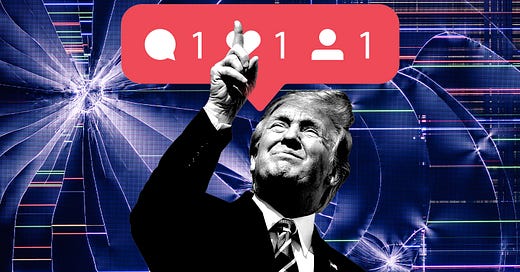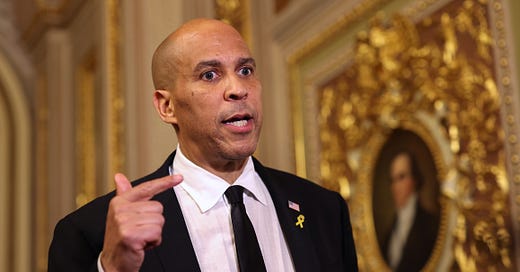
Memestocks + SPACs + NFTs = Trump Social
"Truth Social" is the perfect storm of late-stage capitalism.
Every week I highlight three newsletters that are worth your time.
If you find value in this project, do two things for me: (1) Hit the like button, and (2) Share this with someone.
Most of what we do in Bulwark+ is only for our members, but this email will always be open to everyone. To get it each week, sign up for free here. (Just choose the free option at the bottom.)
1. Money Stuff
Matt Levine covered the Trump Social SPAC bonanza and it was everything I ever hoped it could be.
So if Donald Trump announced “hey I’m gonna do a social media company, buy some stock,” people would buy some stock. And then he’d get a lot of money.[1] And then if the social media platform did not end up being profitable — as I cannot imagine it would be! — then he would, uh, still have that money? And if the social media platform did not end up being launched — if Trump and his crack team of technologists just couldn’t actually build a well-functioning online social network — then he would, uh, still have that money? And if there was no crack team of technologists at all, if nobody even tried to build the social media platform — then you see where I am going with this right?
The point is that if you launch a company with the goal of making it profitable, you have to, like, have a workable business plan and execute on it and deal with a million different operational complexities. If you launch a company with the goal of selling a lot of stock, you have to get people to trust you and give you their money. There is some overlap between those things! But they are different things! . . .
Yesterday, before this announcement, DWAC’s stock closed at $9.96, a bit below the $10 per share that it has in its trust, sort of a standard price for a SPAC with no deal yet. At 11 a.m. today it was trading at about $19.38, implying a valuation for Trump Thing of something like $1.7 billion.[2] If you think Trump Thing is worth $19.38 per share, you are not going to take your $10 back; you’re going to keep the stock and let Trump have your $10.[3] He will definitely get all $293 million.
Why would you think Trump Thing, a company with no product and no revenue, is worth $1.7 billion? Are you looking at the wildly optimistic projections of future revenue in the investor presentation? No you certainly are not! The initial SEC filing doesn’t include an investor presentation, but there is a “Company Overview” deck on Trump Thing’s website, and, fun fact, there is not a single dollar sign in the whole deck. There is no financial analysis, no sources and uses of funds for the deal, no capital structure, and certainly no projections of future revenue. . . .
ou are not buying this stock because you have faith in its optimistic cash-flow forecasts; it has not bothered with cash-flow forecasts. You are buying this stock because you like Donald Trump and think that Tech Monopoly Censorship Threatens Free Speech. Cash flows, valuation, etc., are all irrelevant. It is just vibes.
It does feel a little bit like all of recent financial history has been leading up to this moment? Like, Donald Trump, sure; obviously part of the Donald Trump thing is “I could stand in the middle of Fifth Avenue and shoot somebody, and I wouldn't lose any voters.” Similarly, he can launch a company with no product, business plan or capital structure and the stock will double.
But also the SPAC boom has made it viable for pre-product, pre-revenue companies to go public at multibillion-dollar valuations if they can get enough hype. But also meme stocks have prepared everyone for the notion that the value of a stock is based on the fervor of its community of online fans, not its projected cash flows. But also the cryptocurrency boom seeded that notion, and paired it with libertarianism and resistance to tech-company dominance. But also the boom in non-fungible tokens further proved the idea that membership in an online community has a value that can be captured and financialized and traded and turned into a bubble.
Yes. ALL OF THIS. Read the whole thing.
Just so you understand how memetastic this all is: On Wednesday, DWAC was at $9. By Thursday it was up to $45. As of close of markets on Friday, DWAC’s stock was at $94.
So this stock went from $9 to $94 in 48 hours not because anyone thought that Truth Social could make a profit—as Levine notes, the company business plan does not even include a dollar sign, anywhere—but because one group of people will buy anything Trump and another group of people knows about the existence of that first group.
Cash flows, capital expenditures, growth projections, EBITDA—none of this has anything to do with anything.
You know what this reminds me of?
The betting markets and the 2020 election.
Late on election night, betting markets had Donald Trump as a heavy favorite to win. This isn’t because line-makers thought Trump would win—it’s because all of the action was coming from Trump-loving bettors piling in and putting money on Trump, no matter what was happening in the real world. This tweet, for instance, is from the morning after the election:

Many days after the election result was known, you could still get action betting on Trump to win Arizona and Georgia, or whether or not Donald J. Trump would be inaugurated for a second term on January 20, 2021.
Hell, in February 2021—after Joe Biden was inaugurated—you could go online and bet against suckers who were willing to put money on the proposition that Donald J. Trump would be the sitting president on March 31, 2021.
And who could forget the people who were selling tickets to Trump’s inauguration in December of 2020, more than a month after the election was over and Biden had won?
This is the rare case where I’m fully prepared to testify to Donald Trump’s business acumen: He’s going to make a killing on Trump social because he has a keen understanding, not of the market, but of the marks.
2. The Unpopulist
Shikha Dalmia has started a newsletter that is—God love her—expressly anti-populist.
She has a pretty broad view, with posts about the dangers of populism in Europe and India—but she talks about America, too.
The only logical conclusion is that there are bigger forces at work that have changed the median voter bell curve distribution to a barbell distribution with more voters occupying the extremes rather than the middle. One such force is the GOP’s ability to win elections without having to win a majority of voters, thanks to its Electoral College advantage. It can form a minoritarian government.
McGill University political theorist Jacob Levy points out that in the last 25 years, at no point have self-identified Republicans exceeded self-identified Democrats. “Yet this Republican minority has controlled the presidency, the House and the Senate disproportionately often over those years, winning the presidency twice on the basis of Electoral College-popular vote mismatches, and building up what has been calculated roughly a 7 percent bonus in the House such that if Democrats had won the national popular vote by 6 percent instead of 8.6 percent last November, they probably would not have recaptured control.”
Likewise, Cato Institute’s Andy Craig warns in a very astute piece that “unintended structural consequences of our electoral system” mean that we no longer have an electoral system where the “tipping point is 50/50.” “The Electoral College, the Senate, and to some degree the House and the state legislatures don’t flip from one party to the other unless we hit a tipping point that is skewed decidedly in the GOP’s favor.”
He notes that in the 19th Century, only three times did the Electoral College award the presidency to a man who was a popular runner-up and not the winner. But in the first two decades of the 21st Century, Republicans twice won the presidency while losing the popular vote (Bush, 2000 and Trump, 2016) and almost did so again in the last election. “Just a few tens of thousands of votes in a handful of states stood between Trump and a second term even though Joe Biden had thumped him by more than seven million votes nationwide, or almost four and half percent,” Craig notes.
Indeed, Democratic voters are so inefficiently distributed (with more Democrats in safe red states than Republican voters in safe blue states) that Republicans can win with as little as 46 or 47 percent. Democrats, on the other hand, have to hit as much as 53 or 54 percent to win the presidency. And this gap is only growing. Within a few more election cycles, Craig maintains, a Republican could get into the White House despite losing the popular vote by 5 to 10 percent or even more.
Read and subscribe—it’s free.
3. Big
Matt Stoller’s newsletter is mostly about tech giants, but this edition about the hearing aid cartel is fantastic:
For decades, buying a hearing aid in the U.S. has been an experience in humiliation. Hearing loss is pervasive, with two thirds of people over the age of 70 experiencing some form of it. Despite that, only 20% of people who have hearing loss actually use hearing aids, and one of the big reasons is price. The average cost of such devices is $4700 per pair, for what is essentially an adjustable microphone. . . .
The reason for this excess cost is pure profit margin for the manufacturers. We know this because independent audiologists pay between three to four times as much as Costco does for the same device. So why are hearing aids so expensive? One reason is that the Food and Drug Administration requires a prescription to get one, making it hard to bring cheaper and more innovative devices to market. . . .
The key players in the market are six firms most of us haven’t heard of: WS Audiology, Amplifon, Sonova, GN, Demant, and Starkey. These firms also own a bunch of hearing aid brands, so even if you have a hearing aid that isn’t branded as one of these firms, it’s likely that it comes from one of them.
The competitive dynamics in this field are complex, but the hearing aid cartel uses three basic mechanisms to retain their dominant market power. The first is what’s called a patent pool, which is when a bunch of firms come together to share essential patents, often with the goal of excluding others from the business. . . .
In the hearing aid market, the patent pool is centered in a corporation called the Hearing Instrument Manufacturers Patent Partnership, which holds patents for much of the industry. HIMPP, according to its website, develops, manufactures and markets “over 90% of the hearing technology available to consumers worldwide.” If you want to enter the market with a new device, it’s likely you’ll infringe on one of these patents, which means you’ll have to pay licensing fees, which cost either $2.5 million or 1% in royalties annually. HIMPP also keeps an eye out on “hearing aid related patent activity by parties other than HIMPP partners,” with the goal of opposing granting of patents to non-partners. It is, in other words, a club.
If you find this valuable, please hit the like button and share it with a friend. And if you want to get the Newsletter of Newsletters every week, sign up below. It’s free.











